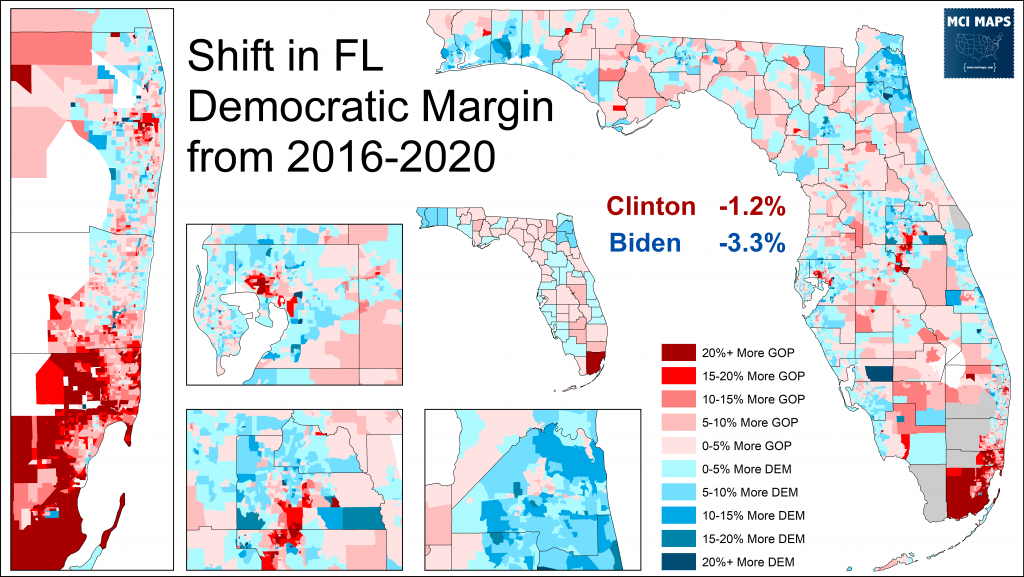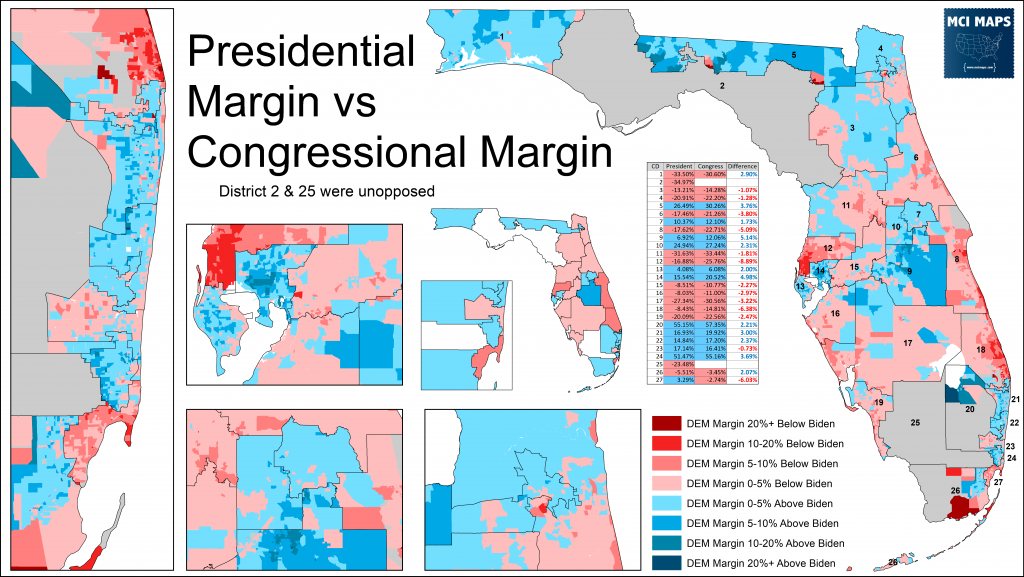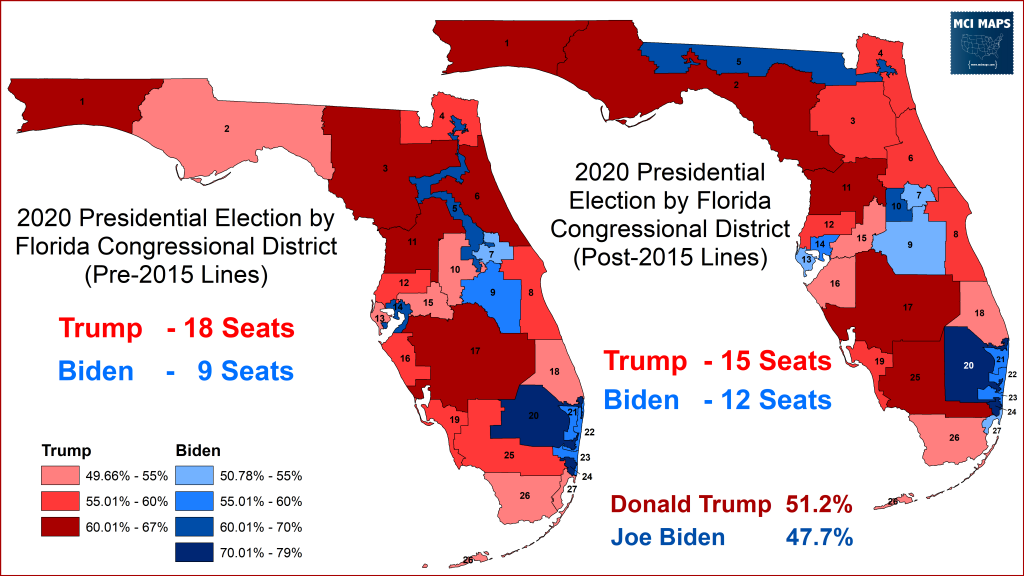In November of 2020, Donald Trump won Florida in his failed re-election bid. He took the state by 3.5% – which was the largest margin since Georgia W Bush’s 2004 win.

The win was primarily thanks to holding the working-class voters he gained in 2020 and major gains with Hispanic voters, as well as more modest gains with other non-white voters. Biden made gains in several suburbs, flipping historically-red Seminole and Duval county, and making some narrow working class gains.

The precinct-digging into Florida is being done by many data researchers and myself, and more will be written here in the future. For this article, I wanted to focus on the results by Congressional district.
How the Districts Voted
In 2020, Trump’s 1% win in Florida translated to winning 14/27 districts. This reflected the fair nature of the current map – which was passed in a very contentious redistricting process during 2015 after the old map was struck down.

In 2018, the districts responded very similar. As Republicans won several narrow races, they carried 14/27 districts. Only the 13th district – represented by Democrat Charlie Crist – split its tickets; giving its vote to now-AG Ashley Moody. You can see my write-up on the 2018 races here.

The 2018 midterm also saw Democrats flip the 26th and 27th districts – resulting them holding all Clinton districts and the delegation being a narrow GOP advantage of 14-13. Heading into 2020, Democrats viewed the 26th as the most vulnerable seat and also had eyes on trying to flip the 15th (with the 16th and 18th being distance stretch shots). What they didn’t count on was the massive swing that would take place with Hispanics in Miami-Dade County.
With Trump’s 3% win this time, he gained one additional district – flipping the 26th district – giving him 15/27 seats. No Republican took the 26th in the 2018 elections and Trump’s win there reflected the massive shifts that took place in Florida’s Hispanic community.

The largest swing between 2016 and 2020 was indeed in the 26th district; which swung by 21.8% to the right. Right behind it was the 25th, which had only narrowly backed Trump in 2020. The swings in Miami-Dade were the most extreme – fueled by massive Democratic collapses with Hispanic voters, Caribbean voters, and Jewish voters. Meanwhile, Biden improved over Clinton very narrowly in the more work-class heavy districts like the 18th and 13th (but worse in the 6th). Biden’s best improvements came in the 4th, which covers the suburbs of Jacksonville, and the 1st, which includes military bases and coastal towns.

I put the swings – including county-level breakdowns – in this google sheet – which is linked here.
As the sheet shows, the biggest swings came within Miami-Dade. The biggest swing was in the 25th district part of Miami-Dade; a 31% swing. Each piece of Dade represents a problem Biden faced. While the 24th, 25th, 26th, and 27th districts have been heavily discussed – the swing in the 23rd district has been mistakenly overlooked. That piece of Debbie Wasserman-Schultz’s district saw a 19% margin swing – a reflecting of Democratic losses with Jewish voters who live in the Northeast Dade region.

Looking at the swing by President is just one way to judge the shift.
When Gillum and Nelson lost their races by under 1% in 2018, one of their biggest problems was Miami-Dade. Their respective 20% margins were too low and I wrote about that extensively in 2019. This time Biden did even worse and its reflecting in him underperforming both both candidates in the Dade districts. The biggest underperformance actually comes from the 24th, which is majority-black and has the largest Caribbean population in the state.

The Southeast collapse was so bad that Biden did worse than Patrick Murphy in his 2016 US Senate run against Marco Rubio. Rubio won that race by a 7.7% margin and hailed from Miami-Dade. Biden did better in most districts, but still underperformed Patrick Murphy in several Miami-Dade based seats – with the largest gap being the 24th. The fact Biden underperformed in the 25th and 26th – despite that being Rubio’s home base – really shows how problematic the slide in SE Florida was for Democrats.

Biden’s biggest improvements over Murphy, meanwhile, were in suburban, educated districts like the 7th, 19th, and 4th.
How Congressional Candidates Compared
Democrats were fairly confident they could hold their 13 seats in the 2020 election, and were aiming to make gains. However, the massive swings in Miami-Dade dashed those plans and caused the 26th and 27th district to flip back to the GOP after just two years in Democratic hands. Democratic hopes to flip any other districts also failed to materialize.

Democratic hopes to flip the 15th went nowhere, which they lost by 10%. GOP efforts to flip the 13th, however, also failed as Democrats held that seat by 6%. Democratic congressman Charlie Crist won by 6%, a bit better than Biden’s 4% in the working-class district with a sizable African-American population. The 7th district, a Democratic gain in 2016, has also continued to move further left of the state – backing Democrat Amanda Murphy by 12% and Biden by 10%. This same district had only narrowly backed Romney over Obama just 8 years ago.
Whether a Democratic candidate for Congress did better or worse than Biden varied by district – though the gap never got especially large. The biggest gap in favor of a Republican was 12th district Incumbent Gus Bilirakis – who outperformed Trump the most in North Pinellas County – a result of upper-income voter ticket splitting and the sizeable Greek population of the area. On the other end, Democratic Congressman Derron Soto outperformed Biden the most in his Puerto-Rican-heavy 9th district – which also saw slide for Biden from four years ago.

The congressional and Presidential results were strongly tied together. There is a 98% correlation between the Presidential and Congressional margin across the 25 districts that were contested. With Donna Shalala being the lone Democrat to lose in a district that voted for her side’s party for President.

While the Presidential and Congressional margins are near-identical – the story behind the two Republican gains tell different stories about that correlation.
The 27th District Race
Of the two Democratic losses in Florida, the 27th is the one that for sure should not have happened. Democrat Donna Shalala lost re-election to Maria Salazar; whom Shalala had beaten two years earlier. Biden’s 3% win was, granted, much weaker than Clinton’s, but he still won and Shalala was an incumbent. While Biden won the district by 3%, she lost by 3% – a six point gap.

That six point difference was the largest Democratic underperformance for any Democratic incumbent and the third worst in the state. So why did Shalala do so much worse? In the end, Shalala was a poor fit for the district. She is not Hispanic and doesn’t speak Spanish – a poor fit for a Hispanic-majority district. Shalala, a former Univ of Miami head and Clinton admin official, won her the Democratic primary in 2018 with just 32% of the vote after outspending all contenders by a considerable sum of money. Her 2018 run against Salazar saw plenty of Democratic anxiety that she was a weak campaigner and a poor fit for the seat – but she managed a win despite underperforming Gillum and Nelson in the seat. In 2020, Shalala was caught by Salazar as the Hispanic community swung right, and Shalala’s underperformance was too much to hold on. Shalala was hurt by flippant comments about socialism and ethnics questions – but the big story is she was a poor fit for the seat from day one.
The 26th District Race
The more heartbreaking Democratic loss is the 26th district. Debbie Mucarsel-Powell pulled off a major upset in 2018 when she ousted Carlos Curbelo. DMP was always considered a prime Democratic target for 2020 and secured a top challenged in Miami-Dade Mayor Carlos Gimenez. The mayor had been a Clinton backer in 2016 who bowed to Trump to secure his support in the GOP primary. Gimenez was likely aided by the county’s COVID handling – despite him getting flack on the right for lockdown and mask support. In the end, Biden’s massive slide in the 26th – which might be the largest in the nation – cost DMP despite her doing slightly better than Biden in the district.

Unlike Shalala in the 27th, there has been plenty of rumbling about DMP running for Congress again or another office. Her loss has been effectively written off as a casualty of other forces and her doing a bit better than Biden has been viewed by Democratic officials as a positive sign. What she does next remains to be seen.
The Effect of Redistricting
With the 2020 elections wrapped up – this marks the last time the current lines will be used for Florida. Redistricting in Florida will begin this year, with a map approved in 2022. Florida is expected to gain two additional congressional districts and the GOP retains full control of redistricting. Florida’s Fair Districts amendments do put some constraints on the GOP, with the biggest ones being respect for city and county borders when possible. The Fair District amendments were used in 2015 to force a new map – but we now enter 2021 with a more conservative state court. As a result it should not be expected the court will be as welcoming to challenges. How far will the GOP try to go? It is hard to say and I’m not especially interested in fantasy-mapping pre-census data. But, the comparison between new and old lines should give Democrats enough to be nervous over. Had the old lines still been in effect, Biden would have only won 9 districts out of 27. That fact alone should make them nervous about what type of map can be thrust upon them.

I really want to stress that what the legislature will do is unclear. Many lawmakers want to avoid years of court battles (regardless of an outcome). They may be constrained regarding the 5th, 10th, 13th, and 14th districts. Let me briefly explain.
- The 5th and 10th – Under the old map, the 5th snaked its way from Jacksonville to Orlando, grabbing all black communities along the way. This meant the old 10th was not the minority-access seat it is now. Under the current lines, Florida has 4 districts that favor African-Americans (5th, 20th, and 24th are VRA seats while the 10th is majority-black in a Democratic primary). A reversion to the old 5th and destruction of a black-favored 10th could subject the court to a Biden-led DOJ lawsuit.
- The 13th and 14th – The reason Crist’s CD-13 is red in the old map is that the 14th used to cross the Tampa Bay to merge black voters in St Petersburg with those in Tampa. The FL Court argued that doing so was illegal packing because the 14th could become a minority-access seat even with the water crossing. A reversal of that just 5 years later could inspire similar lawsuits.
Theoretically anything else is fair game. Though with two new districts likely to be added, the GOP very well could decide to just ensure those are Republican-favored and be satisfied with a 18-11 delegation lead. We will have to wait and see, but Florida Democrats are largely at the mercy of the Florida Republicans – and only lawsuit fatigue may be what saves them from disasters maps.

